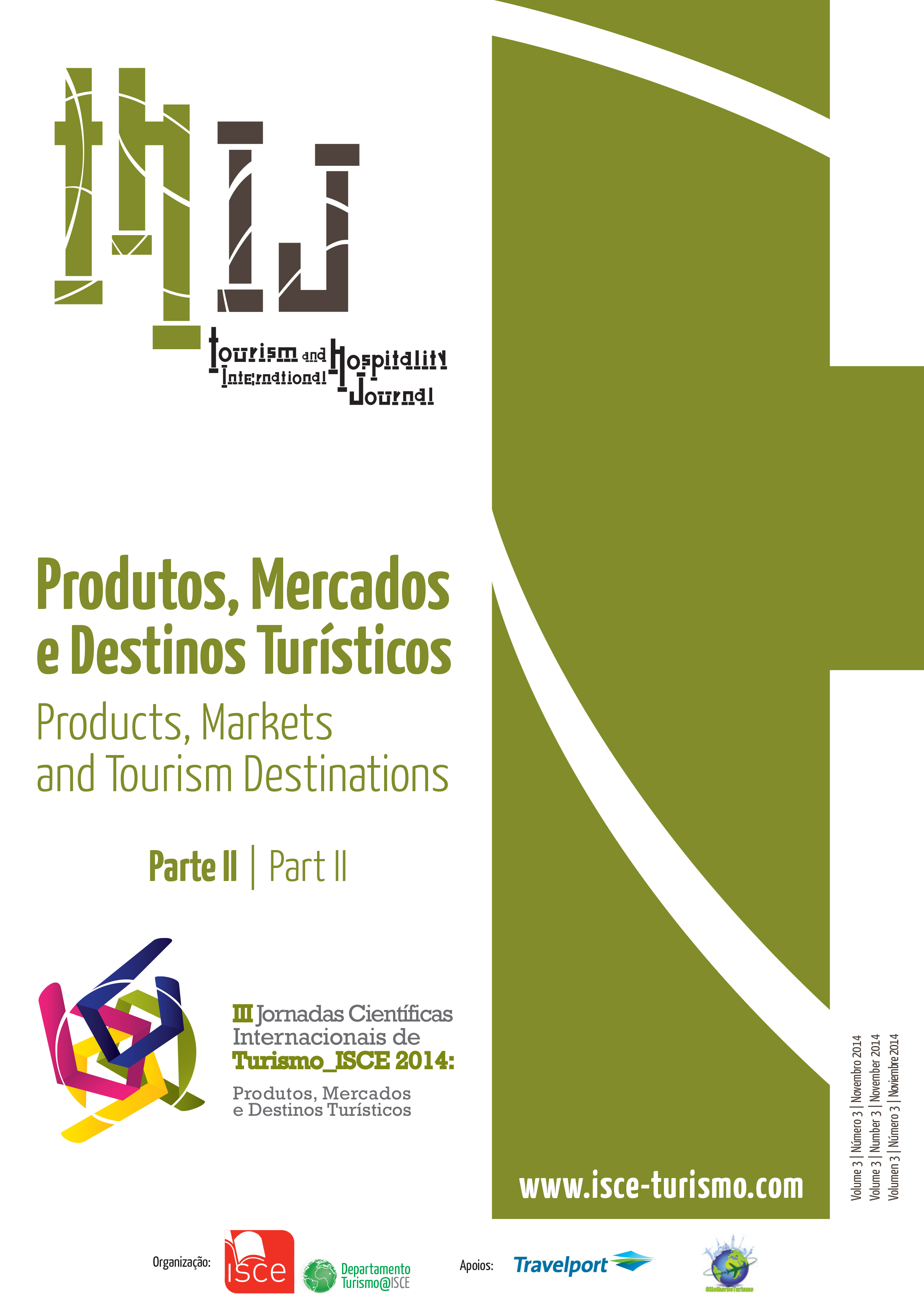Marketing territorial: Propuesta de creación de la marca Beja
DOI:
https://doi.org/10.57883/thij3(2)2014.30146Palabras clave:
Marketing Territorial, Marca, Consumidor, BejaResumen
En un mundo cada vez más global y competitivo, es imperativo que los territorios asuman su papel de creadores de valor que satisfagan las necesidades y deseos de sus consumidores. Es necesario tener una perspectiva real de cómo las pequeñas ciudades pueden no sólo adaptarse a los cambios globales, sino también aumentar su competitividad en el mercado. Este artículo explora las particularidades y potencialidades del marketing territorial y del proceso de creación de marca con el fin de comprender qué factores contribuyen a una buena gestión del territorio, y cómo estos factores pueden utilizarse en la creación de una marca turística para la ciudad de Beja, que refleje los atributos del territorio y cree una imagen más atractiva para su público objetivo. Para analizar este tema se utilizaron dos enfoques distintos: (i) entrevistas con miembros del gobierno regional, la comunidad empresarial y las empresas hoteleras (9) y, a partir de esa información, (ii) construcción de un cuestionario aplicado a 185 turistas y residentes durante 2013.
Citas
Azevedo, A.; Magalhães, D. & Pereira J. (2011). City Marketing: Myplace in XXI. Porto: Editorial SA - Vida Económica.
Baker, B. (2007). Destination Branding for Small Cities: The essentials for successful place branding. Portland: Creative Leap Books.
Beerli, A. & Martin, D. (2004). Factors Influencing Destination Image. Annals of Tourism Research. (31), 657-681.
Bramwell, B. & Rawding, L. (1996). Tourism marketing images of industrial cities. Annals of Tourism Research. 23(1), 201-221.
Bryman, A. (2004). Social Research Methods. England: Oxford University Press.
Cai, L.; Gartner, W. & Munar, A. (2009). Tourism Branding: Communities in Action. Esmerald Books.
Chon, S.; Weaver, A. & Kim, Y. (1991). Marketing your community Image analysis in Norfolk. The Cornell Hotel and Restaurant Administration Quarterly. 31(4), 31-37.
De Holan, M. & Phillips, N. (1997). Sun, sand, and hard currency tourism in Cuba. Annals of Tourism Research. 24(4), 777-795.
Figueira, P. (2011). Marketing Territorial: uma nova dimensão do marketing. Estarreja: Mel Editores.
González, X. (2001). Planeamento Estratéxico e Mercadotecnia Territorial. Eixo Atlântico do Noroeste Peninsular.
Gubrium, F. & Holstein, A. (2001). From the individual interview to the interview society. In J. Gubrium, & J. Holstein (Eds.). Handbook of interview research (3-32). London: Sage.
Gulati, R.; Nohria, N. & Wohlgezogen, F. (2010). Roaring Out of Recession. Harvard Business Review. 63-69.
Hankinson, G. (2006). The Management of Destination Brands: five Guide Principles based on Recent Developments in Corporate Branding Theory. Journal of Brand Management. (14). Harlow: Prentice-Hall.
Jenkins, O. (1999). Understanding and Measuring Tourism Destination Images. International Journal of Tourism Research. (1), 1-15.
Johnson, M. (2001). In-depth interviewing. In J. Gubrium, & J. Holstein (Eds.), Handbook of interview research (103-121). London: Sage.
Ketele, M. & Roegiers, X. (1993). Metodologia da Recolha de Dados. Lisboa: Instituto Piaget.
Kotler, P. & Keller, K. (2007). A Framework for Marketing Management. England: Pearson Prentice Hall.
Kotler, P.; Haider, H. & Rein, I. (1993). Marketing Places. New York: The Free Press.
Lendrevie, J., Lindon, D., Dionísio, L., & Rodrigues, V. (1996). Mercator. Lisboa: Dom Quixote.
Marschan-Piekkari, R. & Welch, C. (2004). Handbook of Qualitative Research Methods for International Business. Edward Elgar Publishing.
Moilanen, T. & Rainisto, S. (2009). How to Brand Nations, Cities and Destinations. London: Palgrave Macmillan.
Morgan, N.; Pritchard, A. & Pride R. (2010). Destination Branding: Creating the Unique Destination Proposition. Oxford: Butterworth-Heinemann.
Porter, E. (1990). The competitive advantage of nations. New York: The Free Press.
Rainisto, K. (2003). Success Factors of Place Marketing: A study of Place Marketing practices in Northern Europe and the United States. Tese Doutoramento. Helsinki University of Technology, Institute of Strategy and International Business, Helsínquia.
Ritchie, B. & Crouch, I. (1993). Competitiveness in international tourism: A framework for understanding and analysis. Paper presented at the 43rd Congress of the International Association of Scientific Experts in Tourism, Argentina. 23-71.
Tasci, A., Gartner, C. & Gavusgil, T. (2007). Conceptualization and Operationalization of Destination Image. Journal of Hospitality & Tourism Research. (31), 198-222.
Therkelsen, A. & Gram, M. (2008). The Meaning of Holiday Consumption: Construction of self among Mature Couples. Sage Publications. 8(2), 269-292.
Descargas
Publicado
Cómo citar
Número
Sección
Licencia
Derechos de autor 2023 This work is licensed under a Creative Commons - Attribution 4.0 International (CC BY 4.0)

Esta obra está bajo una licencia internacional Creative Commons Atribución 4.0.
Este trabalho encontra-se publicado com a Licença Internacional Creative Commons Atribuição 4.0.






